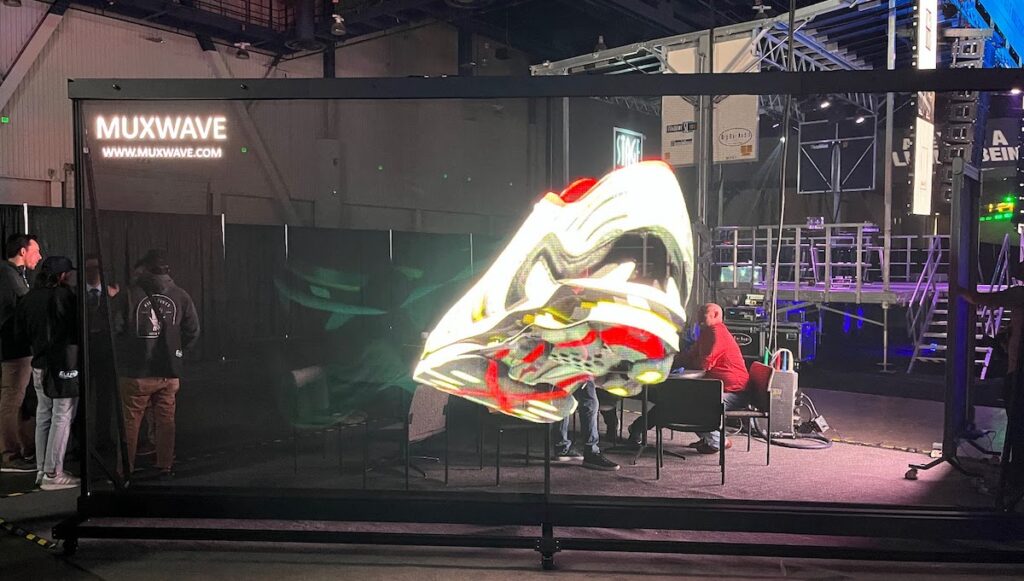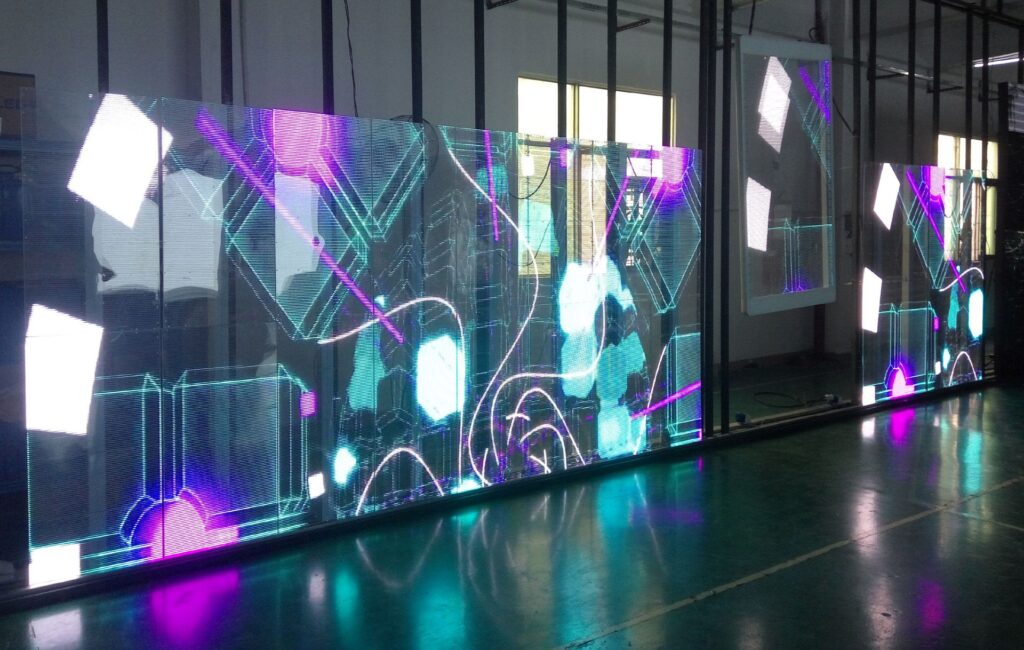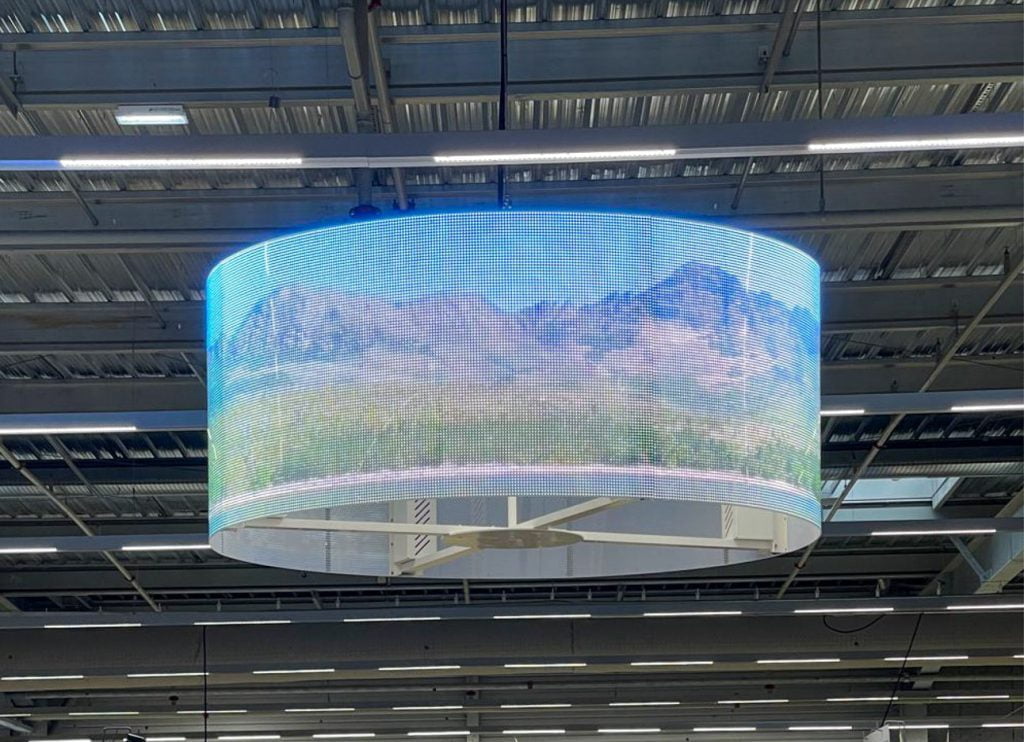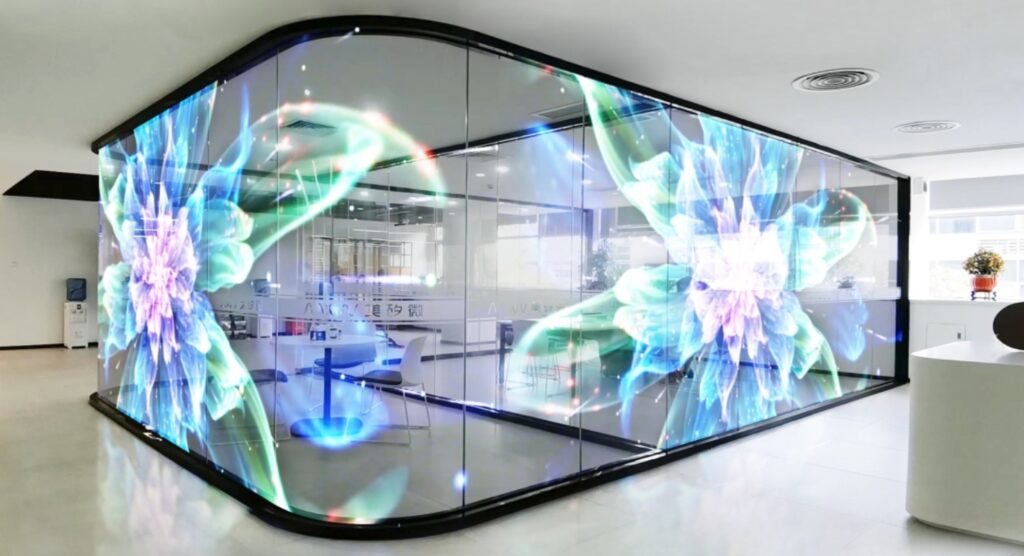A Guide to Transparent LED Screens: Functionality and Features
Table of Contents
Transparent LED screens have emerged as the most captivating display medium, revolutionizing the advertising industry. But what makes them transparent? Transparent LED displays are advanced versions of conventional LED screens.
This cutting-edge technology uses transparent materials to create sharp, vibrant images that captivate the audience in an unparalleled manner. Moreover, they are cost-effective and low-maintenance, making them a prime choice for commercial and advertising uses.
In this article, we will delve into what transparent LED screens are, how they operate, and their potential advantages to the visual world. Let’s get started!

Understanding Transparent LED Screens
Transparent LED screens are innovative display technologies that employ light-emitting diodes (LEDs) to form an image. The LED light is projected onto a transparent surface, enabling visibility from both sides of the screen.
Ideal for interactive displays, these screens leave a memorable impression on viewers. They are energy-efficient and offer a visually pleasing solution for businesses. They can be used for billboards, showrooms, and other public spaces for advertisement/display.
Transparent LED Screen Shapes & Form Options
- Curved Designs: the transparent LED displays with curved designs feature excellent heat dissipation. They are beneficial when installed on elevated ground – providing outstanding visuals, especially from the underneath view.
- Squared or Shaped: transparent LED screen pliable modules can be easily converted or molded into different designs.
- Digital Boards: The LED with the transparent display is also utilized as a video effect board. They show off 3D animations or some play illusions in the shape they must be.
The Functioning of Transparent LED Screens
Transparent LED screens are a blend of LED backlights and transparent LCD glass. This blend enables the LED light to permeate through the LCD glass, creating a bright, clear image that seems to float in thin air. In transparent LED screens, LEDs are placed in a matrix and controlled by a specific controller. This controller sends signals to each LED, forming various images on the screen.
Moreover, transparent LED screens can house millions of tiny LEDs (light-emitting diodes) sandwiched between two film layers. The upper layer is transparent to let the light through, while the bottom layer reflects the light toward the viewer’s eyes. LEDs emit lights of different colors and brightness levels, which amalgamate to create images and videos.
Furthermore, transparent LED screens offer a wide viewing angle. Viewers can see the image from any perspective without any distortion or fuzziness. The LEDs behind the image or video are turned off, while those in front remain lit, giving the illusion of a transparent display and allowing viewers to see through it.
The Construction of Transparent LED Screens
Transparent LED screens are built from a unique mix of materials and components. At the heart of their construction are two glass layers treated with an anti-glare and anti-reflective coating. This ensures the display remains clear even under direct sunlight. A thin transparent LCD panel sandwiched between these two layers contains thousands of pixels, which can be illuminated independently by LEDs.
The LEDs are positioned at the back of the display, topped with a layer of light diffusers to distribute the LED light evenly across the screen. A layer of polarizers then adjusts the light’s brightness and color. A transparent plate finally envelopes the entire structure, creating a flawless, vibrant image without visible seams or edges.

Advantages and Features of Transparent LED Screens
Transparent LED screens are an excellent choice for commercial display needs. Their features and benefits include:
- Increased Visibility: Transparent LED screens provide superior visibility and depth of field, effortlessly attracting the viewer’s attention. Moreover, they offer enhanced image quality with high contrast and sharpness, delivering a clear image.
- Durability: These screens are robust and weather-resistant, making them suitable for indoor and outdoor use. Furthermore, transparent LEDs can last up to 10 years, representing a sound long-term investment for businesses and homes.
- Energy Efficiency: Transparent LED screens consume less energy than traditional LED displays, contributing to a reduced carbon footprint.
- Brightness: Transparent LED screens are daylight-friendly, with brightness settings surpassing conventional LCDs or plasma displays, making them perfect for outdoor use under direct sunlight.
- Versatility and Cost-Effectiveness: With high transparency rates and adjustable brightness settings, transparent LED screens can display images, videos, and information in almost any setting. Compared to traditional display technologies, they are cost-effective and affordable.
- Ease of Installation: Installing transparent LED screens is straightforward and requires no intricate wiring or hardware setup. Their sleek design facilitates easy mounting on walls and ceilings, allowing for swift and easy display setup.
Various Kinds of Transparent LED Screens
Innovatively designed to invigorate any space, transparent LED screens come in a broad spectrum of types, each with unique applications.
Transparent OLED
Organic Light Emitting Diode, or OLED, is a cutting-edge technology enabling transparency in display materials. A transparent OLED constructs interactive visuals that elevate user engagement to an immersive level, allowing light to permeate the display while retaining visibility.
Transparent LCD
The transparent LCD, a distinctive variant of liquid crystal display, enables an image to be seen while light continues to pass through. From advertising to medical imaging, they find extensive usage. By providing a distinctive method to exhibit information, they combine the transparency of glass, making them unique.
Side-Illuminated Transparent LED Display
The side-lighting transparent LED display employs digital signage technology, utilizing light-emitting diodes (LEDs) to create vivid and attention-grabbing visuals. Featuring a layer of see-through material like acrylic or polycarbonate, these displays outshine their conventional counterparts in brightness and visual impact. Withstanding harsh weather conditions, these displays are apt for indoor and outdoor applications where visibility and impact are paramount.
Front-Illuminated Transparent LED Display
Constructed with transparent panels, front-lighting transparent LED displays incorporate LED lights embedded to shine through the panel’s front side. These displays are excellent for advertisements, promotions, and events, providing an awe-inspiring light spectacle. With adjustable brightness and high energy efficiency, these displays consume less power yet deliver maximum brightness, making them an ideal choice for any advertisement or event to distinguish itself.
GOB Transparent LED Display
GOB, which stands for glue-on-board technology, is utilized for crafting high-protection transparent LED screens. Sealing the module surface with transparent glue controls the LED heat dispersion, thus extending the screen’s lifespan. The robustness provided by this technology shields the LED display from drops or impacts.
COB Transparent LED Display
Chip-On-Board, or COB, is a technology in which several LED chips are connected into a single module. The compactness of the chip arrangement significantly reduces the screen size compared to traditional screens. COB transparent LED screens stand out in performance with high light efficiency and a broad viewing angle.
Laminating Transparent LED Display
Laminating transparent LED displays, a contemporary display technology blends the advantages of conventional LED displays with a transparent screen. Offering a premium viewing experience with unparalleled clarity and brightness visible from both sides, these displays are highly energy-efficient and require minimal upkeep.

Guide for Transparent LED Screen Installation
Setting up a transparent LED screen brings a contemporary aesthetic to any environment. Here’s a detailed method for the installation:
- Initially, take accurate measurements of the area where the screen is intended to be set up. Please verify that the space can accommodate both the screen and its frame.
- Tidy up the site and remove any potential obstructions or hindrances affecting the installation.
- Proceed with installing the mounting brackets and ensure they are fastened firmly. Double-check the brackets are level and secure before moving forward.
- Cautiously affix the transparent LED screen onto the installed brackets, ensuring it’s securely positioned to avoid movement.
- Join all the necessary cables and wires that supply power to the screen. Ensure they are connected accurately as per the guidelines provided by the manufacturer.
- Power on your transparent LED screen. Further, make any necessary adjustments to the settings as per your preference. With that, the installation is complete; sit back and enjoy your new visual experience!
Uses of Transparent LED Displays
Transparent LED displays provide a versatile and attention-grabbing solution for numerous purposes. Here are several ways these screens can be put to use:
- Storefronts: Offering vibrant visuals, transparent LED displays can revolutionize the in-store shopping experience by pairing dynamic graphics with physical products, making them the perfect choice for retail spaces.
- Artistic Ventures: These screens open up a world of creativity for artists, offering the ability to create innovative interactive light installations or futuristic digital murals.
- Marketing and Promotion: With the ability to distinguish themselves from the competition, businesses can utilize transparent LED displays for advertising their brand or products. They are particularly effective in high-visibility locations or during significant events.
- Business Gatherings: Creating a compelling ambiance for corporate functions, these screens can exhibit relevant information such as company emblems, messages, or video content, infusing a professional vibe that makes the event unforgettable and engaging.
- Industry Exhibitions: Industry exhibitions become a platform to present new products or services in an immersive way with the assistance of transparent LED displays. They can also provide an impressive backdrop for talks and discussions.
- Outdoor Advertisements: Due to their superior brightness and broad viewing angles, transparent LED displays remain visible even in direct sunlight, which makes them ideal for outdoor applications. Constructed with glass and resilient materials, these displays can endure extreme weather conditions.
- Architectural Glass Walls: Incorporating transparent LED screens into a building’s glass curtain wall can yield a striking display that merges seamlessly with the building’s facade. Their transparency ensures no hindrance to the view from inside or outside, making them suitable for architectural designs.
- Airports: Transparent LED displays can enhance the aesthetic appeal of airports while ensuring visibility and security. They can relay vital information like gate details, flight statuses, or advertisements. They can also offer directional guidance to travelers in various languages. Owing to their energy efficiency and durability, they serve as the ideal solution for bustling airports.
Comparing Transparent LED Screens and LED Glass
Transparent LED screens, or “transparent OLEDs” and LED glass, can project visuals onto a clear surface. Transparent LED screens comprise light-emitting diodes (LEDs) arranged on a thin film, which is subsequently affixed to a transparent glass or plastic base. This structure permits the projection of images and videos onto a transparent surface.
In contrast, LED glass uses an electroluminescent technology, embedding LEDs directly into the glass structure. The connected LEDs form various patterns and shapes, creating visuals directly on the glass surface. Although both options offer visual display capabilities, the transparent LED screens tend to have superior image quality, largely due to their higher resolution resulting from precise pixel placement. This enables the creation of vibrant visuals with more distinctive details than an LED glass display.
Additionally, transparent LEDs offer ease of installation and cost-effectiveness compared to LED glass, eliminating the need for extensive wiring or structural adjustments. However, regarding durability, LED glass is more resistant to external damage, such as scratches and impacts. Ultimately, both transparent LED screens and LED glass possess distinct advantages and disadvantages, and the choice between the two largely depends on individual requirements. Both technologies could be well-suited for a range of digital display projects.
Benefits of Transparent LED Screens Over Conventional LED Displays
Transparent LED screens exhibit marked improvements over conventional LED displays. The reasons for this are outlined below:
| Features | Transparent LED | Traditional LED |
| Brightness | Significantly brighter; displays provide a crisp and clear image even in brightly lit areas. | Less bright than transparent LED screens and has less crisp images. |
| Durability | More durable and not affected by heat or dust buildup. | They are less durable as they are prone to heat damage and dust buildup |
| Aesthetics | A sleek, modern look that blends in with the environment | Bulkier, more intrusive look |
| Cost | Affordable and cost-effective. | Expensive than transparent LED screens |
Conventional LED displays often have a limited viewing angle and subpar image quality. They are typically bulky and do not offer long-term cost-effectiveness or durability. In contrast, transparent LED screens offer a wider viewing angle and superior image quality. They have a neutral, understated aesthetic and provide increased durability and cost-effectiveness. However, it should be noted that transparent LED screens require more maintenance than traditional LED displays.
Contrasting Opaque and Transparent LED Screens
Opaque and transparent LED screens are two varieties of LED displays with unique characteristics. The distinctions between them are as follows-
| Opaque LED Screens | Transparent LED Screens |
| Opaque LED screens do not allow light to pass through them. | Transparent LED screens allow light passage. |
| They provide a one-sided view. | These screens provide views from both sides. |
| Opaque LED screens are ideal for indoor uses. | Best for both outdoor applications. |
| They are best for places where the viewer is closer to the screen. | These LED screens support distant visibility. |
| Affordable in comparison to Transparent LED screens. | A bit expensive due to its advanced features. |
| Common Usage: Retail displays, Stage backdrops, and other similar applications. | Common Usage: Building facades, Billboards, and other similar applications. |

Key Factors to Mull Over When Selecting a Transparent LED Screen
Choosing a transparent LED screen for your venue requires careful deliberation of multiple elements.
Pixel Pitch vs. Pixel Density
Pixel pitch, the space between two pixels, and pixel density, the number of pixels per square inch, are crucial elements to focus on. With a smaller pixel pitch and larger pixel density, your screen can produce remarkably clear images with finer details. This factor is critical for transparent LED screens as it enables the display of images with outstanding clarity and vivid colors, enhancing the visual appeal for your audience. Thus, understanding the appropriate mix of pixel pitch and pixel density can help create breathtaking displays.
Transparency Percentage
The level of light penetration through the screen, denoted by the transparency rate, greatly influences the screen’s performance. Opting for a screen with a higher transparency rate will enhance visibility, boost brightness, and refine color accuracy while lessening eye fatigue, particularly for prolonged users.
Moreover, screens with elevated transparency rates can contribute to energy efficiency because they require less electricity due to the increased light passage. Hence, investing in a transparent LED screen with a high transparency rate can offer an energy-efficient and reliable display solution.
Brightness Levels
Ensuring a luminous display is key for content to be visible, even under intense lighting conditions. By modulating brightness based on the display’s purpose, the content can be made more conspicuous and captivating. Greater brightness can also improve color contrast, making images and text appear more defined. This is particularly effective for digital signage applications.
Also, screens with higher brightness levels can alleviate eye strain, allowing users to view content comfortably for extended durations. Hence, a high-brightness transparent LED screen is a wise investment for optimizing your viewing experience.
Dimensions
Transparent LED screens are available in various sizes, ranging from as petite as 2 inches to several meters. Before purchasing, you must evaluate the size that fits your needs and the available space.
Resolution Quality
A screen with a higher resolution provides clearer image quality. Therefore, verify the resolution of your prospective transparent LED screen to ensure it meets your criteria.
Screen Variety
Transparent LED screens come in two types: active-matrix and passive-matrix. You must decide which type suits your project best. Although active-matrix screens generally offer superior image quality, passive-matrix screens are often more budget-friendly, albeit with potentially differing image quality.
Durability and Consistency
Precision engineering and top-quality materials are required for transparent LED screens to function seamlessly and have an extended lifespan. They should be robust enough to resist environmental factors like rain, wind, and UV rays while consistently providing clear visuals. A screen that is not sturdy and dependable could break down prematurely or produce visual distortions under specific conditions. Hence, investing in a high-quality screen ensures consistent performance over the long haul.
Economical Installation and Maintenance
Cost-efficient installation and maintenance can yield substantial savings in the long run. Innovations such as automated systems can cut down labor costs, while routine cleaning and inspections can ward off expensive repairs or replacements in the future. Thus, prioritizing efficiency during installation and maintenance can maximize your cost savings.
Cost Comparison
With a vast range of brands and models, it’s important to compare prices before finalizing your purchase to ensure it aligns with your budget.
Guidelines for the Installation and Maintenance of Transparent LED Screens
- Opt for Superior Transparent LED Screens: Quality is the key to installing and maintaining transparent LED screens. Purchasing a reliable and long-lasting product guarantees your screens’ longevity and peak performance.
- Choose an Ideal Location: Ponder on the placement of the transparent LED screens. They are best positioned in a locale with natural light and a clear view.
- Guarantee Adequate Ventilation: Ensuring your transparent LED screens are situated in a well-ventilated area is crucial. This approach mitigates overheating.
- Inspect the Mountings: Check that the mountings are compatible with the size and weight of your screen. Confirm it’s firmly attached, and remember to apply suitable padding between the screen and mount to ward off any potential vibrational damage.
- Securely Fit Power Cables: Take special care with power cable placement during setup. Fasten them securely to prevent tripping hazards and ascertain that electrical outlets are safe and capable of sustaining your screen’s wattage.
- Link to a Dependable Power Source: Connecting your transparent LED screen to a stable power source such as a UPS or generator is critical to mitigating the risk of power outages or fluctuations. This will help ensure the seamless display of your content.
- Consistently Clean the Display: Routine cleaning of the display aids in keeping your content clear and legible. Dust or grime can interfere with visibility.
- Keep a Close Eye on the Temperature: Maintaining an optimal temperature range for transparent LED screens is essential for peak performance. Hence, regularly monitoring the temperature can help prevent issues.
- Reduce Glare: Minimizing glare from either natural or artificial light can enhance screen visibility. Consider using opaque curtains or shades where applicable.
- Employ Anti-Glare Filters: Incorporating anti-glare filters can diminish screen reflection, improving the viewer’s experience. They are an excellent supplement to a transparent LED screen system.
Conclusion
To wrap up, the popularity of transparent LED screens is on the rise due to their versatile benefits. They not only enhance the aesthetics of any space with their modern and stylish look but also offer visual appeal, energy efficiency, and longevity. They also provide more creative liberty and content accessibility than traditional displays.
As the technology evolves, the range of applications will likely expand, adding to their appeal. Transparent LED screens are transforming our perspective of the world and opening up new possibilities for both businesses and individuals.
MyLikeLed is your go-to manufacturer for top-notch LED strips and LED neon flex. Our products undergo rigorous testing in high-tech labs to guarantee superior quality. We also offer customization options for our LED strips and neon flex. For the finest LED strips and LED neon flex, contact MyLikeLed today!
FAQs
Transparent LED screens are commonly used in retail store windows, shopping malls, museums, airports, and corporate buildings. They’re ideal for places that want to display dynamic content without blocking natural light or the view inside.
The main benefits of transparent LED screens are their ability to attract attention without blocking visibility, save energy, provide high brightness even in daylight, and create a modern, high-tech look for businesses.
No, transparent LED screens are generally designed for easy installation. Many models are lightweight and modular, which makes it simple to mount them onto glass surfaces, walls, or custom frames.
Yes, some transparent LED screens are built for outdoor use. These models are weatherproof and have higher brightness levels to stay visible even under direct sunlight.
Maintaining a transparent LED screen is relatively simple. Regularly clean the surface with a soft cloth and mild cleaner, check connections, and make sure there’s no dust buildup on the LEDs to keep the display running smoothly.

Hi, I’m Xylia Xiong, a sales professional with 14 years of experience in the LED strip light industry. I specialize in providing tailored solutions, leveraging my expertise in LED products and the latest industry trends. Known for effective communication and problem-solving, I’m dedicated to helping lighting manufacturers, importers, and distributors achieve their goals.
Let’s work together to create customized solutions that exceed expectations.
Related Posts

The Best LED Strip Lights You Can Buy Right Now

Comparing WS2811 Vs WS2812B: Key Differences


